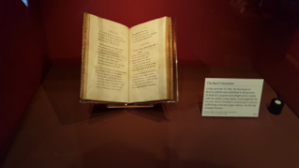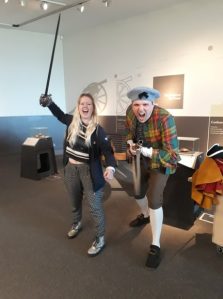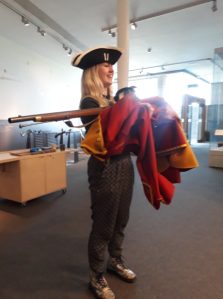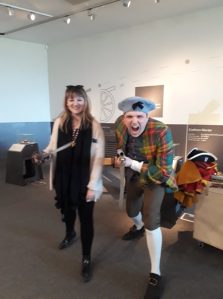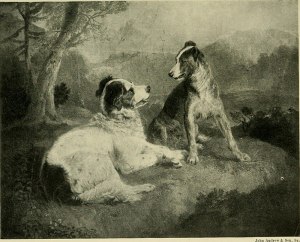National Trust for Scotland
Meet the Team: Yves Laird
During this time of isolation and social distancing we find ourselves in, relying on digital technology to communicate has never been more important, and we wanted to help curb any loneliness and boredom by branching out with a new series of blogs about our staff. Our team were presented with ten questions to answer to help you to get to know them better. Next time you visit our Museum in Alloway, perhaps you’ll remember the name and the face of one of our staff members, helping you feel more connected #ForTheLoveOfScotland.
So without further ado, let us introduce to you…
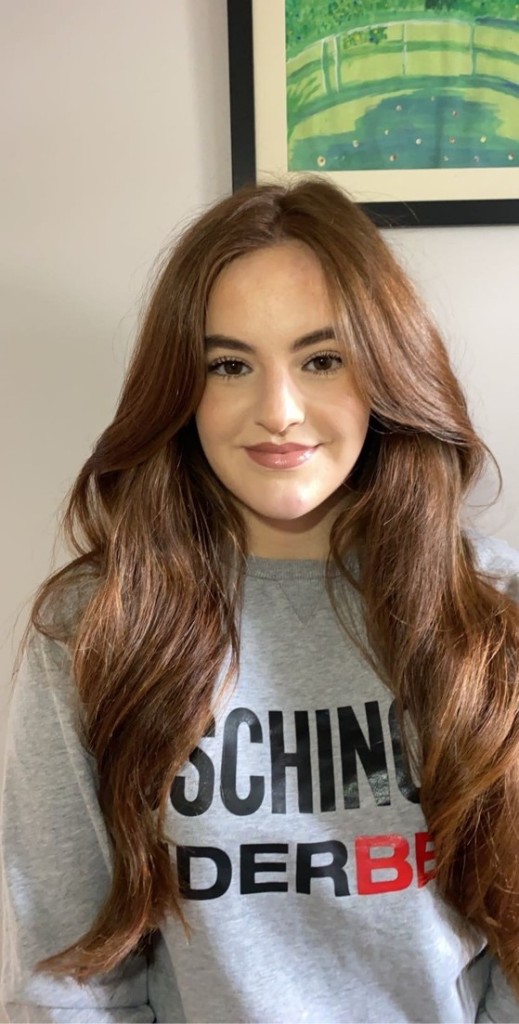
1. Name
- Yves Laird
2. How long have you worked at RBBM?
- 11 Months
3. What is your position at RBBM?
- Visitor Services Assistant (Catering)
4. What is your favourite thing about working (or best memory) at RBBM?
- I love being able to work among a great team of people in the heart of Alloway to provide our local community and worldwide visitors with service fit for a bard!
5. What is your favourite fact, song and/or poem by Robert Burns?
- As an English Literature student, not only do I appreciate Burns’s own work, but the works he provided inspiration for. His poetry is said to have inspired John Steinbeck’s 1937 novel ‘Of Mice and Men’, specifically by a line in the poem ‘To a Mouse’.

6. What is your favourite Scots word?
- Wheesht! Meaning be quiet as in “haud yer wheesht!”
7. Do you have any special skills/hobbies/talents? (Doesn’t need to be work related, let’s see your hidden talents!)
- I’m close to having an architectural degree, as seen in my Tunnocks teacake towers!
8. What is your dream vision/project?
- I would love to work in the emergency services! On a less realistic note, have my yet- to- be written novels published in the literary canon.
9. Who is your idol and why? (can be famous, could be your granny….up to you!)
- Prince! As a creative genius who wasn’t afraid to push boundaries, his commitment to his work and art form shines through his great works. The fact he wasn’t afraid to stand out from the crowd and was able to walk away from those who held him back is truly inspirational.

10. Where is your favourite place in the world and why?
- While the rain pours down 361 days of the year here, I’m proud to say home is Scotland. Nowhere can beat it with its rugged scenery, tranquil lochs and (mostly) friendly people!
Meet the Team: Chris Waddell
During this time of isolation and social distancing we find ourselves in, relying on digital technology to communicate has never been more important, and we wanted to help curb any loneliness and boredom by branching out with a new series of blogs about our staff. Our team were presented with ten questions to answer to help you to get to know them better. Next time you visit our Museum in Alloway, perhaps you’ll remember the name and the face of one of our staff members, helping you feel more connected #ForTheLoveOfScotland.
So without further ado, let us introduce to you…

1. Name
- Christopher Waddell
2. How long have you worked at RBBM?
- Seven Years
3. What is your position at RBBM?
- Downtrodden and defeated. Oh you mean work wise?! I am the Learning Manager.
4. What is your favourite thing about working (or best memory) at RBBM?
- I really enjoy when we get a great class of kids who engage with the site and subject matter. They make me laugh and inspire me sometimes with their outlook and knowledge of the world. I enjoy working alongside the team too, despite my continual joking and rude comments I really am very fond of them. Mostly.
5. What is your favourite fact, song and/or poem by Robert Burns?
- Fact – Burns was familiar with literary heavyweights – such as Alexander Pope – when he was in his mid-teens, and drawing inspiration, was able to compose pieces such as ‘Now Westlin Winds’ at such an early age. This qualifies for me the notion that he was a genius.
- Song – The Lea Rig
- Poem – a bit obvious but probably ‘Tam O’ Shanter’.
6. What is your favourite Scots word?
- Gowdspink, but a’hm no tellin ye whit it means, ye’ve tae awa an fun oot fur yersel!
7. Do you have any special skills/hobbies/talents?
- I can identify most plants and beasts you’ll see on a walk through the Scottish countryside and then tell a whole raft of dull facts to anyone who will listen.
- I can play the moothie and recite the script from ‘Goodfellas’(not at the same time).
8. What is your dream vision/project?
- To completely immerse myself in a rural idyll.
9. Who is your idol and why? (can be famous, could be your granny….up to you!)
- Loads of people, but in reality my late father who was great inspiration to me and a good friend and I miss him very much, and, a bit soppy here, my lovely wife because she puts up with me with amazing good humour and endless tolerance.
10. Where is your favourite place in the world and why?
- Difficult to choose between Sicily or Arran, both places I have been very happy and always in the company of my wife.
Meet the Team: Lauren McKenzie
During this time of isolation and social distancing we find ourselves in, relying on digital technology to communicate has never been more important, and we wanted to help curb any loneliness and boredom by branching out with a new series of blogs about our staff. Our team were presented with ten questions to answer to help you to get to know them better. Next time you visit our Museum in Alloway, perhaps you’ll remember the name and the face of one of our staff members, helping you feel more connected to our property.
So without further ado, let us introduce to you…

1. Name
- Lauren McKenzie
2. How long have you worked at RBBM?
- 6 months (Started in September 2019)
3. What is your position at RBBM?
- Events Manager
4. What is your favourite thing about working (or best memory) at RBBM?
- My favourite memory so far has been delivering the Burns programme in January. The team put in an immense effort to pull together all of the elements for the weekend and it was a very proud moment for me to see the success of this. I, of course, have to mention the incredible team of staff and volunteers that work at RBBM that make everything so enjoyable and easy!!
5. What is your favourite fact, song and/or poem by Robert Burns?
- My favourite Burns song is ‘My Love Is Like A Red, Red Rose’.
6. What is your favourite Scots word?
- It has to be ‘braw’. Braw means beautiful, pretty, attractive… you could call a lassie braw or you could say “it’s a braw day the day”.
7. Do you have any special skills/hobbies/talents?
- I have played in a brass band for over 12 years and somehow manage to find the time to compete on regional and national levels in between events at the museum!
8. What is your dream vision/project?
- My dream is to visit every continent in the world – only South America and Australia to go!!
9. Who is your idol and why?
- I am going to cheat a wee bit and have two – both my grannies! Although, I am biased, they are just the BEST in the world and have taught me everything I know.
- If it was to be someone famous, it has to be the Spice Girls (again, cheating because there is five of them!) I have loved them since a really young age – GIRL POWER!

10. Where is your favourite place in the world and why?
- I have travelled to a few places but there is nothing quite like being home in Ayrshire – it’s fair braw.
Bards, Burns an Blether in The Bachelors’

It’s owre twa hunner year syne The Bachelors’ Club in Tarbolton saw the young Robert Burns an his cronies speirin aboot the issues o thaur day. It is therefore a braw honour tae gie this historic biggin a heize ainst mair by bein involved in organisin and hostin monthly spoken word an music nichts in the place whaur Robert Burns fordered his poetic genius, charisma an flair fir debate.
The Bachelors’ Club nichts stairtit in March this year eftir Robert Burns Birthplace Museum volunteer Hugh Farrell envisaged the success of sic nichts in sic an inspirational setting.
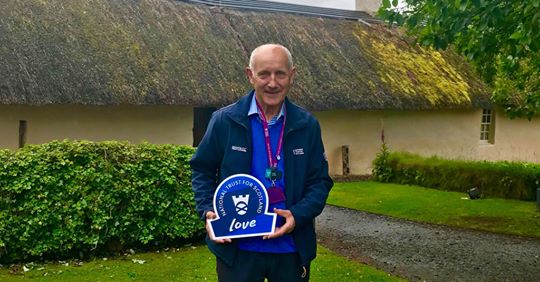
Tuesday the third o September saw the eighth session, an it wis wan we will aye hae mind o. Wullie Dick wis oor compère as folk favoured the company wi a turn.
Oor headliner wis Ciaran McGhee, singer, bard an musician. Ciaran bides an works in Embra an I first shook his haun some twa year syne at New Cumnock Burns Club’s annual Scots verse nicht. The company wis impressed then an agin at the annual “smoker” an at a forder Scots verse nicht. Ciaran traivelled doon tae Ayrshire tae play fir us, despite haen jist duin a 52 show marathon owre the duration o Embra festival.
Ciaran stertit wi a roarin rendition o “A Man’s a Man for a That”, an we hud a blether aboot hoo this song is as relevant noo, in these days o inequality an political carnage, as it wis twa hunner year syne, a fine example o Burns genius an insicht. Ciaran follaed wi Hamish Imlach’s birsie “Black is the Colour”, the raw emotion gien us aa goosebumps!! Ciaran also performed Johnny Cash’s cantie “Folsom Prison Blues”, an then Richard Thomson’s classic “Beeswing”, a version sae bonnie it left us hert-sair! Ciaran also performed tracks fae his album “Don’t give up the Day Job”.

The company wir then entertained by Burns recitals an poetry readins fae a wheen o bards an raconteurs. A big hertie chiel recited “The Holy Fair”, speirin wi the company on hoo excitin this maun hae buin in Burns day, amaist lik today’s “T in the Park”.
We hud “Tam the Bunnet” a hilarious parody o Tam o Shanter an Hugh Farrell telt us aboot the dochters ca’ad Elizabeth born tae Burns by different mithers, Burn’s first born bein “Dear bocht Bess”, her mither servant lass Bess Paton. Later oan cam Elizabeth Park, Anna Park’s dochter, reart by Jean Armour, an thaur wis wee Elizabeth Riddell, Robert an Jean’s youngest dochter wha deid aged jist 3 year auld. A “Farrell factoid” we learned wis that in Burns day, if a wee lassie wis born within mairrage, she was ca’ad fir her grandmither, if she wis born oot o wedlock she taen her mither’s first name. Hugh recited “A Poet’s Welcome To His Love-Begotten Daughter” fir us, the tender poem Burns scrievit, lamentin his love fir his first born wean, Elizabeth Paton.
We hud spoken word by various bards on sic diverse topics as a hen doo, a sardonic account o an ex girlfriend’s political tendencies, an a couthie poem inspired by a portrait o a mystery wummin sketched by the poets faither. In homage tae Burn’s “Poor Mailie’s Elegy”, we hud a lament in rhyme scrievit in the Scots leid, featurin the poet’s pet hen.
We learned o the poetess Janet Little, born in the same year as Burns, who selt owre fowre hunner copies o the book o her poetry she scrievit. This wummin wis kent as “The Scotch Milkmaid” an wis connected tae Burn’s freen an patron, Mrs Frances Anna Dunlop.

We also learned o hoo Burns wis spurned by Wilhelmina Alexander, “The Bonnie Lass of Ballochmyle” an hoo, eftir her daith, she wis foun tae hae kept a copy o the poem Burns scrievit fir her.
We hud mair hertie music fae Burness, performin Burns an Scottish songs sic as “Ye Jacobites by Name” an a contemporary version o “Auld Lang Syne” wi words added by Eddie Reader tae an auld Hebrew tune.
We hud “Caledonia” an “Ca the Yowes tae the Knowes” sung beautifully by a sonsie Auchinleck lass wha recently performed it at Lapraik festival in Muirkirk (oan Tibby’s Brig nae less!).
The newly appointed female president o Prestwick Burns Club entertained us on her ukelele wi the Burns song “The Gairdner wi his Paiddle” itherwise kent as “When Rosie May Comes in with Flowers”.
At the hinneren wi hud a sing alang tae Seamus Kennedy’s “The Little Fly” on the guitar an Ciaran feenished wi “Ae Fond Kiss”, interrupted by his mammy wha phoned tae see when he wis comin haim tae New Cumnock!
We hud sae muckle talent in The Bachelors’, that we didnae hae time fir a’body to dae a turn, so thaim that didnae will be first up neist time.

A hertie thanks tae a the crooners, bards an raconteurs an tae a’body in the audience fir gien up thaur time, sharin thaur talent an ken an gien sillar tae The Bachelors’ fund. Sae faur we hae roused £862 which hus been paid intae the account fir the keepin o The Bachelors’ Club.
Hugh Farrell is repeatin history by stertin a debatin group in The Bachelors’ on Monday 11th November, 239 year tae the day syne Burns launched it first time roon. Thaur will be a wee chainge tae the rules hooever, ye dinnae hae tae be a Bachelor an ye dinnae need tae be a man tae tak pairt!!
The Bachelors’ sessions are oan the 1st Tuesday o every month 7pm tae 10.30pm an a’body wi an enthusiasm for Burns is welcome.

Scrievit by Tracy Harvey, Resident Scots Scriever fir RBBM
Volunteers Week – Roger Alexander
For Volunteers Week, we asked our volunteers to write a blog post about their volunteering experience. Here’s Roger Alexander sharing some of his thoughts.
I retired from full time work eleven years ago; having spent the first five of those with The Conservation Volunteers, I came to RBBM just over six years ago as a “Buggy” driver. This involves meeting and greeting visitors, transporting them on the buggy between the Museum and Burns Cottage (or any other places the buggy will reach) and helping with other information and advice where I can.
As with most volunteering, the job rarely stops there. I now find myself helping out from time to time in all sorts of other ways, which I find very rewarding and stimulating, and it helps me feel part of the team.
Driving the buggy allows me to meet a whole range of interesting folk from all four corners of the planet and I am constantly amazed at how well Robert Burns is known even in the smallest and most remote of islands. However, these global travellers offer a wide range of stimulating conversation which is rarely restricted just to the “Bard”.
The Volunteers at RBBM also help run a Garden Shop, situated in the grounds of the museum, which offers a wide variety of goods manufactured by local crafters and is also a shop window for the RBBM itself. However, the main purpose of this venue is to raise funds for the restoration and improvement of the Burns Monument which is just one of the bold and innovative ideas being developed by the management team at RBBM.
One variation on the theme, which I particularly remember, was the great fun we all had on Halloween one year, volunteers and staff together, creating and acting out a costume drama incorporating the Burns Cottage, Poets Path and “Auld Kirk” and providing lots of “bloodthirsty” and scary moments for those visitors brave enough to come back after dark!
I find volunteering a great way to keep fit and active, meet new people and maintain a standard of life which rarely falters, and you may go a long way before finding a better place to do all this than with the team at RBBM and the beautiful countryside surrounding it.
Volunteers Week: Hugh Farrell
For Volunteers Week, we asked our volunteers to write a blog post about their volunteering experience. Here’s Hugh Farrell sharing some of his thoughts.
As a lifelong admirer of Robert Burns, a past president of four Burns Clubs and past secretary of a fifth, I volunteered to be a guide as soon as the National Trust came to Alloway. Indeed, wild horses could not have held me back! Confirmation that Robert Burns was the prime mover for my desire to become a volunteer.
To have the opportunity to immerse myself in the history of the Cottage and to find myself walking in the footsteps of the young Robert Burns is wonderful. Another plus is the opportunity to meet people who arrive from all around the world to visit the birthplace of Scotland’s National Bard who remains, in my opinion, The International Bard of Humanity. Then there are the thousands of schoolchildren who visit every year who we seek to inspire but who also inspire their guides. The children are encouraged to recite or sing their “Burns “ party pieces and a great many are really delighted to do so.
I always try to bring Robert Burns’ love of Scotland to the fore and note the light that comes into the eyes of visitors when I quote his poetry, songs or prose.
Communication is of course a two way process and whilst it pleases me to speak of the history of the Cottage, I am also intrigued to hear the tales of the visitors such as the American historian who informed me that Robert Burns was the first National Poet of the USA.
The first known Burns Supper was held in the Cottage in 1801, and continued to be held there until 1809, after which time it was relocated to the Kings Arms Hotel in Ayr.
The Supper was returned to the Cottage on 25th January 2016 and has now become a fixture on the calendar. It is organised by the volunteers of the Friends of the Museum, with superb support from NTS staff, and is a major fundraiser.
There are many activities to be involved in at RBBM, some for fundraising and some for fun. There are various crafts and activities, and even a chance to scare visitors at Halloween as they are guided through the gardens to the haunted Auld Kirk of Alloway! (They then went on to the Cottage where Doctor Hornbook, a Burns character, was performing an amputation!)
As a volunteer guide, I also take tours of the Robert Burns Birthplace Museum where I can expand on the life and times of our Bard as we view the great number of artefacts that are on display.
The question is often posed as to what is my favourite item, or song, or poem. The answer is always “too many to cover in such a short time.” However Robert Burns’ Kilmarnock Edition, where it all began, might be a good starting point.
I have written of the fantastic times that I have with our visitors but there is also so much pleasure in the camaraderie within the volunteer team and between volunteers and NTS staff members who support us in everything we do.
Retirement from the “day job” is the end of an era. Volunteering is the beginning of a better era.
Volunteers Week: Myra McLanaghan
For Volunteers Week, we asked our volunteers to write a blog post about their volunteering experience. Here’s Myra McLanaghan sharing some of her thoughts.
I didn’t really volunteer for the Trust – it sort of found me. I was a regular at the Wednesday Highlight talks at the RBBM and the Volunteer Co-ordinator approached me, thinking I would be interested. Of course, you always believe that you have nothing to offer and need qualifications etc.; but the thing is, you suddenly find that you have life experiences of qualifications and so I took the plunge of becoming a Volunteer.
I started off doing craft work, making rag rugs. So, with other volunteers, I commenced making a rag rug for Burns Cottage, where we would sit on a Monday afternoon cutting up fabric and creating our masterpiece. As people came through we found that nostalgia was a big part in discussion and visitors would discuss the rag rug, who made it in their family and what it was even called in different parts of the country. Overseas visitors were most intrigued, and children even tried their hand at putting a piece of material into the rug. The group are now on their third rug and we are now expanding into learning about weaving and dyeing of fabrics on the 18th century. From little acorns large oaks grow.
I have also become involved in a performance team who dress in 18th-century costume and perform the works of Burns. Our overseas visitors really appreciate us in costume and they feel part of what we are trying to tell them about life in Scotland during Burns’ time. Being a volunteer expands your experiences and confidence. I have a natural love for Scotland and volunteering has added a new dimension of meeting new people and making new friends and sharing a common love of Scotland and Robert Burns in the area where not only did I grow up, but he did too.

Myra (second from right) with some more rag ruggers, and their finished product, in Burns Cottage
An Awfie Symbolic Seat
Date: 1858
Object Number: 3.4521
On display: in the museum exhibition space
This remarkable chair is made of wood sourced from the Kilmarnock printing press which produced the first edition of Robert Burns’s work Poems Chiefly in the Scottish Dialect known as ‘The Kilmarnock Edition’. It was published on the 31st July 1786 at the cost of three shillings per copy. 612 copies were printed and the edition was sold out in just over a month after publication. The printing press no longer exists but in its stead there are two statues: one of Burns and one of John Wilson (the owner of the press) to commemorate the publication of Burns’s first works.
This chair was constructed in 1858, just before the Burns Centenary Festival in Ayr in 1859. The one hundredth year anniversary of the bard’s birth was celebrated far and wide by many. One contemporary counted 676 local festivals in Scotland alone, thus, showing the widespread popularity of Burns.

The chair has plush red velvet on the cushion and is elaborately carved with symbolism and references to some of Burns’s most loved works. Each arm rest ends with a carving of a dog, Luath and Caesar, from the poem ‘The Twa Dogs’.

A carving of Robert Burns himself, after the artist Alexander Nasmyth’s famous portrait – whereby he is shown fashionably dressed in a waistcoat, tailcoat and stalk – is placed in the centre at the highest point of the back of the chair with the infamous characters Tam and Souter Johnnie from the narrative poem ‘Tam o’ Shanter’ on either side. Thistles, commonly regarded as the floral national emblem of Scotland, decorate the gaps between the figures.

The central carving is of the climactic scene of Tam crossing the Brig o’ Doon atop of his trusty cuddie (horse in Scots) Meg with Nannie the witch at their heels. The Brig o’ Doon is actually a real bridge and is located in Alloway where Burns was born and lived for seven years.


A small plaque above this quotes a verse from Burns’s poem ‘The Vision’ which was written in 1785 and published in Poems, Chiefly in the Scottish Dialect. It takes the form of a poetic ‘dream vision’, a form used in medieval Scottish verse and revived by Allan Ramsay in his own poem ‘The Vision’, from which Burns takes his title and was influenced and inspired by immensely. In the long narrative poem, Burns as speaker returns from a hard day in the fields and, after resting by the fireside, falls into a dream state in which he is visited by Coila, a regional muse. Coila (whom the speaker is clearly attracted to) addresses Burns, describing how she watched his development from a young age – thereby offering an imaginative reworking of Burns’s emergence as a poetic talent. She ends with a confirmation of his poetic mission and crowns him as bard. The striking thing here is the self-consciousness Burns displays about his position even this early in his career.
The inclusion of these particular carvings could be symbolism of the themes in which Burns explored most through his works: nature with the dogs representing this; the supernatural via the Brig o’ Doon scene; comradery through Tam and Souter Johnnie the “drouthy cronie” and the nature of the self and humankind through the quote from ‘The Vision’ and Robert Burns himself.
Interestingly, during a visit to Burns Cottage in 1965, the boxing legend Muhammad Ali was pictured sitting in this chair. Following this visit he was made an honorary member of Alloway Burns Club. If you are intrigued by this then please read a previous blog by volunteer Alison Wilson about an extraordinary meeting to do with this celebrity visit to Alloway here: https://burnsmuseum.wordpress.com/2016/06/13/memories-of-muhammad-ali/.
By Parris Joyce, Learning Trainee.
Burns on Beasties
On the BBC’s website it is listed that there are 118 poems written by our beloved bard Robert Burns with the theme of nature, however, I would argue that there is so many more as nature – a subject which was very close to his heart – is inextricably intertwined in a number of his works.
The reason nature is a genre featured so heavily within Burns’s works can be traced back to his upbringing and lifestyle. Being born in the but-and-ben Burns Cottage in Alloway, he was introduced to the ways of farmlife from childhood. He worked with his family closely there and at multiple farms thereafter such as Mount Oliphant and Lochlea Farm. Burns and his brother Gilbert even farmed at Mossgiel Farm when his father died. He did not just have connections with the land in his younger years but as an adult as well as he worked as a farmer alongside his career as a poet and songwriter. His last farming endevaour was at Ellisland Farm in Dumfrieshire. His rural upbringing and argicultural employment earned him his nickname as “The Ploughman Poet” by the artistocratic society of Edinburgh. Burns lived in Edinburgh for only two years – the city which he described as “noise and nonsense” – to return to his rural roots.
Firstly, I would ask: what is nature? It is defined as the phenomena of the physical world collectively, including plants, animals and the landscape. Burns did not neglect any of these three aspects and used them frequently as the inspiration of his works. He did various works which refer to plants such as To a Mountain Daisy, My Luve is Like a Red Red Rose and The Rosebud. Some of my personal favourite works of Burns which talk about other environmental features include Sweet Afton (about a river) and My Heart’s in the Highlands (which of course is about one of the most rugged, scenic and breath-taking landscapes in the world).
However, what this blog will mainly focus on is that Burns was most notably an animal lover. This is conveyed in his works On Glenriddell’s Fox Breaking his Chain, The Wounded Hare, Address to a Woodlark, The Twa Dogs, To a Louse and the renowned and much adored To a Mouse. This last poem – which was written in 1786 and published in the Kilmarnock Edition – is a perfect example of Burns’s humanity as this poem reflects his concern for animal welfare, his consciousness of humankind’s effect on nature and has empathy for a small creature which is widely considered as “vermin”. This was very ahead of his time and is a concern that is currently proving to be a huge issue as more and more animals become extinct because of human’s destructive actions in the twenty-first century.
The Twa Dogs poem, written in 1796, is another great work of Burns’s which gives the two dogs human-like intellect and the ability to express themselves as it has an upper-class pedigree, Caesar, and an ordinary working collie, Luath, who chat about the differing lives of the social classes. The name “Luath” comes from Ossian’s epic poem Fingal. The Twa Dogs immortalizes Burns’s own dog Luath who came to a cruel end. On the morning of 13th February 1784 Robert and his sister Isabella were distressed to find the poisoned body of Robert’s dog Luath outside their door – the act of a vengeful neighbour. Arguably, Burns intended this poem as a memorial to his canine friend.
An example of one of Burn’s lesser-known poems is The Wounded Hare which was written in 1789. Below are the first three stanzas out of five that complete this poem:
Inhuman man! curse on thy barb’rous art,
And blasted be thy murder-aiming eye;
May never pity soothe thee with a sigh,
Nor ever pleasure glad thy cruel heart!
Go live, poor wand’rer of the wood and field!
The bitter little that of life remains:
No more the thickening brakes and verdant plains
To thee a home, or food, or pastime yield.
Seek, mangled wretch, some place of wonted rest,
No more of rest, but now thy dying bed!
The sheltering rushes whistling o’er thy head,
The cold earth with thy bloody bosom prest.
The word choice makes the moral message of this poem is clear: Burns is vehemently opposed to shooting. The passion and intensity of Burns’s thoughts on this is quite surprising as one would think that as a farmer he would be used to or even dependent on killing animals, however, meat consumption was not as prominent in the eighteenth century as farm animals were only killed for food in old age or special occasions. The family’s provision of milk, cheese, butter and wool came directly from their own animals, and the health and wellbeing of these creatures were paramount. Furthermore they would share the same roof over their heads with them, thus creating strong bonds with their farm animals, and apparently Burns lost his temper with a farm-worked once when the man did not cut the potatoes small enough and Burns was frantic that the beasts might choke on them.
Below is the third stanza of the powerful poem On Glenriddell’s Fox Breaking His Chain written in 1791:
Glenriddell! Whig without a stain,
A Whig in principle and grain,
Could’st thou enslave a free-born creature,
A native denizen of Nature?
How could’st thou, with a heart so good,
(A better ne’er was sluiced with blood!)
Nail a poor devil to a tree,
That ne’er did harm to thine or thee?
Again, you can clearly see that Burns is opposed to the cruel treatment of a “free-born creature” and is in disbelief of the actions of the good-hearted Glenriddell’s actions.
However, one could argue that nature was so deeply rooted in Burns’s psyche – and he quite literally was surrounded by it living on a farm – that he could not escape from being inspired to write about it. An example of this is in his masterpiece Tam o’ Shanter. It is an epic narrative poem written in 1790 which features folklore, superstition, witchcraft and gothic themes… but it also has one of his most poignant and beautiful quotes in which Burns really philosophically details the nature of nature:
But pleasures are like poppies spread,
You seize the flower, its bloom is shed;
Or like the snow falls in the river,
A moment white–then melts for ever;
Or like the borealis race,
That flit ere you can point their place;
Or like the rainbow’s lovely form
Evanishing amid the storm.–
Nae man can tether time or tide;
The hour approaches Tam maun ride;
Burns is saying that nature’s beauty is wistful, forever-changing and is out of the control of humankind as he insightfully states “nae man can tether time or tide”.
In terms of this poem, another point is worth mentioning: the hero of this tale is a horse. Again Burns’s admiration and respect for animals is encompassed in the heroism of Meg, Tam’s horse, who against all odds does get him home in one piece although the same cannot be said for her. Burns was a brilliant horse-rider and would have relied heavily on his four-legged companion as a mode of transportation to socialise, to plough fields and to work as an excise man.
All in all Burns would have been regarded nowadays as an advocate for animal welfare and his works which have animals or nature at their core reflect his love for nature and are some of his most passionate, most thought-provoking and most heart-rending.
By Parris Joyce (Learning Trainee)




